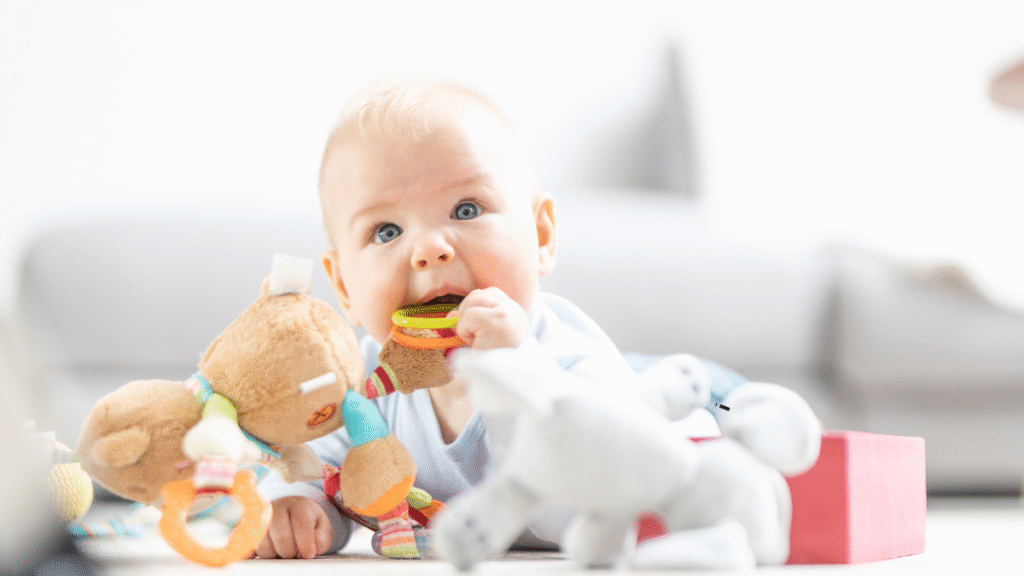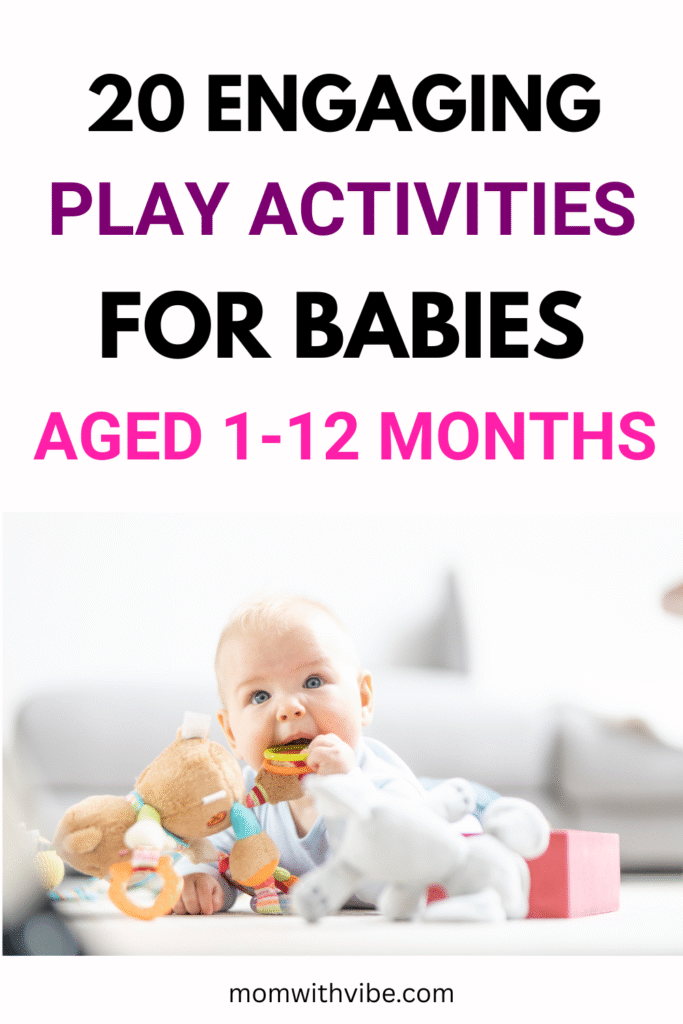The first year of the existence of your baby is an adventurous stage of growth and development. Babies at this period are educated regarding the environment around them with the use of play. Play fundamentally goes a long way in the development of cognitive, motor, and social skills as well as strengthening the bond between you and your baby. Little children require fun and exciting activities to keep them occupied. In this list, 20 excellent ideas are being discussed which are best suited to a baby aged between 1-12 months.
1. Tummy Time
Tummy time is a very important exercise that a young child should get, as it builds the muscles of the neck, shoulders, and arms. It assists them to acquire the abilities involved in rolling over, crawling, and even walking. To make tummy time interesting, you can use colored toys placed slightly out of reach and this will make your baby push upward and lift his or her head. It is also possible to use a mirror to keep them busy in front of them.
Example: During tummy time, you can put a soft toy in front of your baby and slowly make them reach out to take it. This will, in the long run, facilitate coordination and muscle strength.
2. Mirror Play
Babies are interested in self-image. Place a mirror that is baby-safe and let your child learn about his reflection. This assists in the creation of self-identification and visual tracking. You may also use faces in the mirror to interest them more. Even babies as young as 2 months can become interested in the reflection of their own image.
Here’s an example: Get your baby in front of the mirror and say his name and point at his or her reflection. You can also make funny faces and check whether they would start smiling or laughing.
3. Rattle and Soft Toy Play
Soft toys and rattles are very good for making babies develop hand-eye coordination. When they shake or grasp the toy, they also develop their small motor abilities. Toys of bright color, various textures, and sounds attract the attention of your baby. At 3 months, your infant can possibly begin to reach independently towards items.
Illustration: Shake a rattle in front of your baby and ask him or her to reach it. When they grow older, you can present them with the rattle and allow them to shake the rattle on their own.
4. Sensory Bags
Put some objects of different textures in a see-through plastic bag, which can include rice, water beads, or cloth. Close the bag and allow your baby to discover it by pushing, squishing, or tapping it. Tactile activities engage your baby through exploring the sense of touch by using sensory bags. It is possible to make different sensory bags of various textures to make things interesting.
Examples: Fill one with water beads and another one with crinkly paper. Allow the small baby to discover the difference in feel.

5. Interactive Storytime
A great way to enhance language development in your baby is reading to them. Select books that have a board book format with clear images, textures, or flaps, which your baby can touch or interact with. Say in various tones of voice and point at the pictures to make the experience interesting and educational. At the moment, your baby will not understand the words, but they will enjoy hearing you and will gain benefit from watching the pictures.
E.g.: In younger babies, books with high-contrast black-and-white photographs may be used. Once they reach their prime, they should be introduced to books with simple but colorful illustrations and interactivity.
6. Peek-a-Boo
This popular game is evergreen. Cover your face with your hands or a piece of cloth and then burst out and say, “peek-a-boo!” The surprise and the bond it forms are adored by babies. This game teaches how to have object permanence and assists with social progress. Between 3-4 months, you should have started playing when your baby has just begun to realize the meaning of object permanence.
Example: A soft blanket or cloth can be used in playing peek-a-boo where one conceals their face and then shows their face. Your baby may even start playing the game with you when he/she gets older.
7. Gym Play
A hanging toys bouncer will make your baby reach out, bat, and kick. This is good for motor skills and hand-eye coordination. Finally, add in a mirror or colorful toys to visually stimulate them more. By the time your child is approximately 3 months old, they will have fun attempting to hold the hanging toys.
An example is placing your baby close to a gym with hanging soft toys or a mirror. Coax them into hitting the toys or gazing into the mirror.
8. Music and Dance
Music is simply awesome to exercise the brain of the baby. Singing pleasant tunes to your infant or at least soft rhythms. You can also rock them and sway in your arms or move their body to the music. This assists in creating a sense of rhythm and can be a soothing bonding experience. Music is also important in assisting sensory development.
Example: Play a lullaby during rest time and energetic music during playtime. Move to the music together with your newborn baby or just sway your body along with it.
Related: 100 Popular Indian Celebrity Baby Names and Their Meanings
9. Water Play
Water play is a great sensory task. Put some water in a shallow basin or small water table and allow your baby to splash around, scoop, or play with floating toys. Your baby should never be left unsupervised in case they are near water and it is important to have water at safe temperatures. Water play stimulates the child, and fine motor skills can be developed.
An example is how you should put your baby’s hands in the water and help him or her splash or use a small plastic cup to scoop some water.
10. Baby Massage
A soft massage of a baby allows relaxation, blood circulation, and muscles building. Apply a baby-safe lotion or oil and gently rub their arms and legs as well as back. It is a calming action and a ritual that can help your baby sleep better and be less stressed. It is also such a great bedtime ritual to gently massage your baby before bed.
Example: When the baby is getting ready for bed after taking a bath, apply a rich lavender-perfumed oil to his or her soles and legs and massage the feet gently. This may help in easing before bed.
11. Sense of Touch Sensory Play
To stimulate your baby through touch, use soft materials, toys with different textures, or even a sensory mat of changing materials (i.e., velvet, cotton, or foam). They should be allowed to touch and experience various textures, and this encourages sensory development. Fine motor skills and inquisitiveness are well stimulated by tactile play.
Example: Make a texture board using pieces of soft, rough, and bumpy fabrics allowing your baby to touch them with their hands.
12. Crawling Games
Crawling babies or those preparing to crawl can be faced with an easy obstacle course formed with pillows or blankets to allow crawling and help coordinate body movements. Another thing that you can do is to roll a ball just beyond the reach of your infant so that he or she will crawl towards it.
An example is the use of soft pillows or a blanket path which your baby can crawl. This will stimulate them to crawl and strengthen the muscles.
13. Floating Balls
Take a shallow container and fill it with water and put light balls in it that float. Teach your baby how to float or spin the balls in the water. This promotes exploration via the senses and brings about the phenomenon of cause and effect.
Example: Have your baby observe how the ball floats over the water and ask him or her to reach out and touch the ball. This can assist in showing the ability to track and coordination between the hands and the eyes.
14. Stacking Blocks
Show your baby how to stack blocks or cups. To begin with, your baby may just love knocking them down but as they get older, they will start stacking them up. This requires manipulations to assist with fine motor skills, hand-eye coordination, and problem-solving.
Example: Use bulky, colored nesting blocks. Stack them one on top of the other and then you watch your baby knock them down and attempt it again.
Related: 50 Cute Foreign Baby Boy Names and Their Meanings
15. Baby-Friendly Art
Your baby should be introduced to art through non-toxic crayons or finger paints. It is possible to prepare handprint art or allow them to play with large pieces of paper to draw colorful marks. This exercise is associated with the development of creativity and motor skills, even when the painting is more abstract!
Example: In babies who are just beginning, finger painting with a big piece of paper would work. Allow them to touch the colors and texture using their hands.
16. Sensory Bottles
Put colorful things, such as beads, buttons, or glitter, into clear bottles. Close the bottles and allow your baby to shake the bottles in order to discover the sounds and appearance. Sensory bottles assist in stimulating the hearing and seeing senses in your baby.
Example: Fill a sensory bottle with water and glitter and one with tiny beads that make sound when moved around. Allow your baby to shake them and see their eyes flare up.
17. Baby Play Mat
A padded play mat that has various textures and has toys embedded in the mat is safe and gives your baby room to experiment. Search for play mats of different colors, mirrors, and hanging toys to entertain them during the time when they are learning motor skills and coordination.
Play example: Prepare a play mat with some mirrors, some crinkly fabric, and some soft toys to dangle over. This will prompt your baby to play and stretch out to grasp things.
18. Bubble Play
Playing with bubbles is interesting and entertaining. Your baby will love to see the bubbles floating in the air. Ask them to track the bubbles with their eyes, which will assist in enhancing visual tracking. Popping colored bubbles together can be an added bit of fun as well.
Example: Hold bubbles close to your baby and see him or her stretch out in an attempt to pop the bubbles. It is an excellent game to enhance hand-eye coordination.
19. Soft Toy Adventures
Act out little stories with soft toys and make it a playful story indeed. You should discuss with your baby the things that those toys are doing and talk in different tones to have better amusement. It is the activity which encourages language growth and prepares early storytelling.
E.g. Take a stuffed animal and act out a trip somewhere. You should ask questions to your baby and make them touch the toys.
20. Gentle Swinging
Swinging back and forth in a baby swing or in your arms can be fun as well as relaxing. The movement assists in balance and coordination. Playing a lullaby or soft music during the swinging of your baby improves the relaxing effect and also cements your relationship.
Illustration: Swing your baby gently or put him/her on a baby swing. You can also massage and sing through a lullaby by swaying and humming until they become calm.
Final Thoughts
Play is a vital part of your baby’s growth and development as it offers them learning, growth, and time together. These 20 activities stimulate the senses, promote motor development, and give enjoyable experiences that aid in cognitive and emotional development, helping your baby grow.
Incorporating these play activities into your everyday activities, you are encouraging your baby to establish a solid base of learning and exploration in the future. Make the most out of these quality times playing with your baby as they grow, develop, and explore the world.
FAQ
Q: How frequently should I do these activities with my baby?
A: Use these activities every day of life. Even brief training with 10-15 minutes would help. Concentrate on the type of activities that your baby enjoys, and as they grow, you can extend the duration of play.
Q: At what age can I start tummy time?
A: You can begin tummy time as soon as a few weeks into your baby’s life. Start with 2-3 minute sessions and gradually extend them as your baby becomes stronger.
Q: How can I tell when an activity becomes too much for my baby?
A: Listen to your baby. When they appear hyperactive, whiny, or fatigued, it is best to rest. Babies require a lot of rest and off-time, so alternate playing with naps and calm time.
Q: Is it possible to do all these activities inside the house?
A: Yes, all these activities can be done inside, although some (water play, bubble play, etc.) might be simpler outdoors. Just make sure that there is no danger or risk in any way to your baby.
Q: What are safe toys for babies under 6 months old?
A: For babies below 6 months, look for toys that are soft, non-toxic, and easy to clean. Avoid anything small that could be swallowed, and instead opt for toys that encourage the senses (such as rattles or soft/fabric toys).
Save the pin for later




